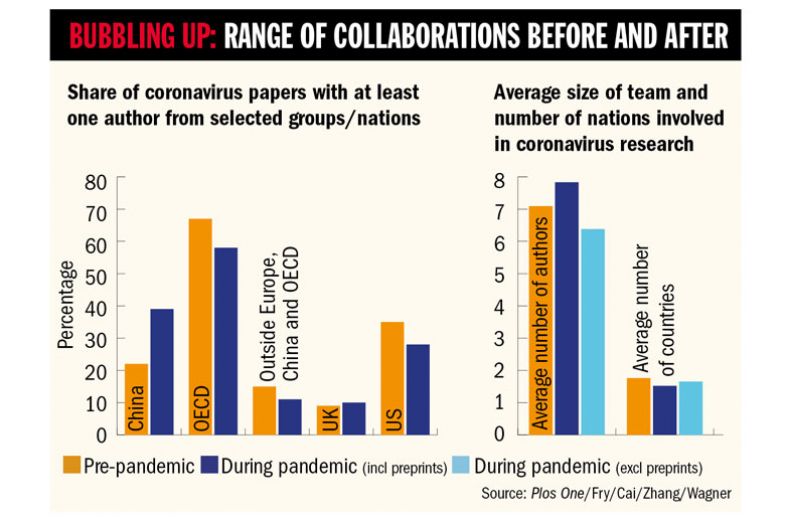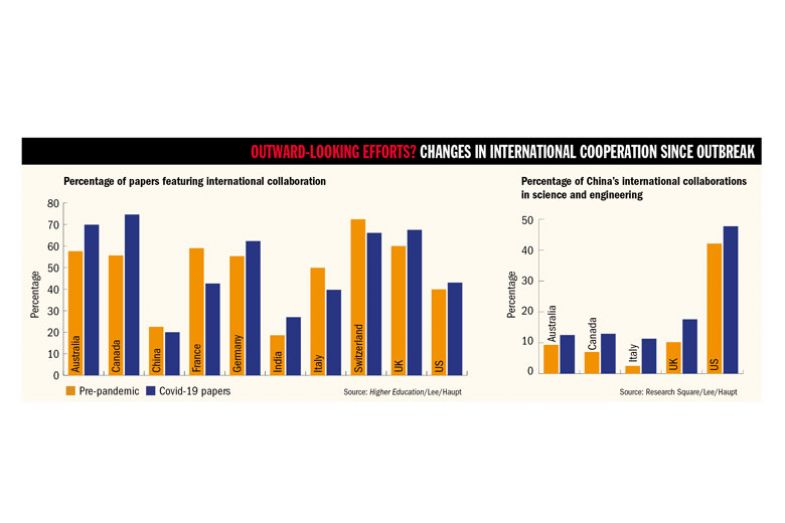Before the coronavirus pandemic, international research collaboration was already becoming a major focus of attention for scholars and policymakers wanting to understand the interplay between science and cross-border cooperation.
In the main, such collaboration between academics across the globe was accepted as a desirable goal that could boost the citation impact of work and accelerate progress.
But Covid-19, and its disruption to international travel, has caused a profound shock to the international network of scholars, whose collaborations were often sparked by chance meetings at conferences or scientists travelling far across the globe for new posts in other countries.
It may still take some time before the true impact of this is known, but early data on collaboration since the pandemic hit are starting to emerge and may give some comfort that scientists – possibly spurred by the global nature of the crisis – are continuing to seek to work with colleagues far and wide. However, the data are also revealing interesting subtleties around the collaboration that has been taking place.
Two peer-reviewed studies and a preprint published in the past few weeks in particular offer some insight into collaboration in the first few months of the crisis.
The first, involving authors based in the US, China and Australia, analysed publications on coronaviruses, including those associated with other illnesses such as Sars and Mers, in the two years before the pandemic and from January to April this year.

Although the study inevitably found that the countries that were first to feel the impact of the pandemic, such as China, had boosted their share of research on coronaviruses, other interesting patterns also emerged.
These included an apparent narrowing in the number of authors and countries involved in such research, a strengthening of the research ties between China and the US, and a potential drop-off in the involvement of smaller and developing nations.
The paper, published in the journal Plos One, says the findings “suggest that the global Covid-19 pandemic shifted the geographic loci of coronavirus research, as well as the structure of scientific teams, narrowing team membership and favouring elite structures”.
One of the paper’s authors, Caroline Wagner, the Milton and Roslyn Wolf chair in international affairs at Ohio State University, said it was important to remember that the study reflected “international collaboration as it responds to a shock” and the “scramble” among scientists in the early days to discover more about the virus.
Although Chinese researchers “reacted first and rapidly”, the data suggest that US researchers, individually and then in teams, and other major research nations such as the UK became more and more involved as time went on.
Professor Wagner said the research’s finding that there had been a “tendency for elites to connect with each other” was also a feature of collaboration before the pandemic.
But the data do suggest that involvement from developing countries dropped in the pandemic period (just 11 per cent of papers had an author from a country outside Europe, the Organisation for Economic Cooperation and Development and China) and the average number of nations on each peer-reviewed paper fell overall.
Meanwhile, the share of papers featuring authors from both the US and China grew from 3.6 per cent to 4.9 per cent.
This theme of the US and China seemingly strengthening research ties during the pandemic, or at least not loosening them because of any geopolitical tensions, is also picked up in other research on collaboration during the pandemic.
Two researchers from the Center for the Study of Higher Education at the University of Arizona looked at international collaboration patterns in research specifically on Covid-19, compared with cross-border working generally in the years before the pandemic.
One of their main overall findings, in a peer-reviewed paper published in the journal Higher Education, was that international collaboration on Covid-19 research from January to May this year was much higher than for articles published in the five years before: more than a third (34 per cent) of Covid-19 papers featured cross-border working, compared with 23 per cent in the period 2015-19.
The pandemic appears not to have dented non-Covid collaboration this year either, which was at 28 per cent.
However, there are interesting variations among countries. Several major research nations had a higher level of collaboration on Covid papers published this year, but China’s collaboration percentage was slightly lower (20 per cent compared with 22 per cent in 2015-19 and 25 per cent for non-Covid 2020 papers), a leaning towards domestic output in China that has also been suggested in other collaboration studies.
An additional preprint study by the same authors, Jenny Lee and John Haupt, published on Research Square, also found that the US and China were among three countries (the other being Mexico) that tended to collaborate with authors from fewer than three other countries on Covid-19 papers, suggesting that their internationally co-authored research “tended to be bilateral”. In all, almost half of all China’s international collaboration on Covid-19 featured a US author.

Professor Lee, who published a separate study last year on the growing research ties between the countries, said she had found it interesting “that despite the mounting geopolitical tensions between the two countries, scientists from the US and China are collaborating together, even more than prior to the pandemic”. This “tells us that scientists are especially prone to coming together in addressing global crises”, she added.
However, it was hard to tell whether this heightened collaboration was a result of the profound shock of the pandemic and the urgent desire for knowledge about Covid-19 and whether geopolitical tensions would come into play in the future.
“The pressing need for global solutions to Covid-19 appears to have triggered heightened scientific cooperation, but policies that discourage immigration, ban funding sources and monitor scientists as potential spies obviously make collaboration across borders difficult,” she said.
Professor Wagner also said the longer-term picture on collaboration was uncertain, but she said challenges would include reigniting new networks and bringing emerging countries back into the fold.
“Right now, mobility is severely constrained, so this obstacle will likely hinder the initiation of collaborations,” she said. “This ‘gap year’ may also harm novelty, since new ideas are born in the churn of people and ideas that lead to breakthroughs, discoveries and novel recombinations.
“Also of concern is the rapid drop-off of developing countries from Covid-19 international collaborations. A collective policy effort may be needed to bring developing country participants back into international collaboration.”
Find out more about THE DataPoints
THE DataPoints is designed with the forward-looking and growth-minded institution in view
POSTSCRIPT:
Print headline: Boundary-busting virus reshapes cross-border efforts
Register to continue
Why register?
- Registration is free and only takes a moment
- Once registered, you can read 3 articles a month
- Sign up for our newsletter
Subscribe
Or subscribe for unlimited access to:
- Unlimited access to news, views, insights & reviews
- Digital editions
- Digital access to THE’s university and college rankings analysis
Already registered or a current subscriber?




